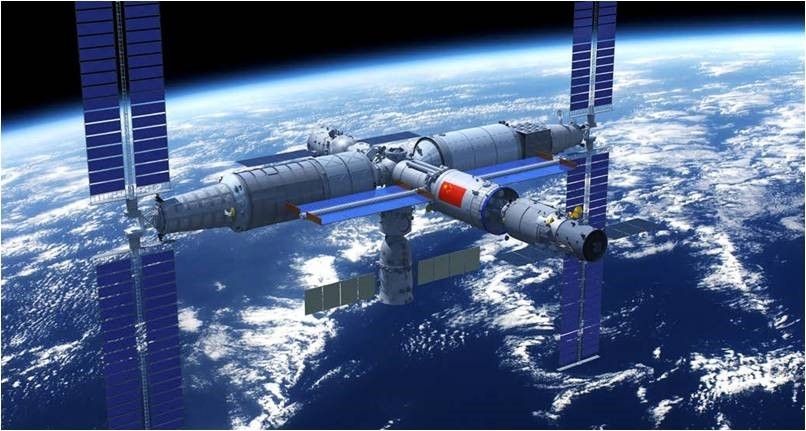
International Experiments Selected for China's Space Station
Six experiments are going up for sure, and three more were conditionally accepted.

The United Nations Office for Outer Space Affairs (UNOOSA) and the China Manned Space Agency (CMSA) announced Wednesday (June 12) the winners of their joint opportunity to conduct experiments on board the China Space Station (CSS), which is scheduled to be built in the next few years.
Six winning projects were selected, and three were conditionally selected. They were carefully evaluated by a team of around 60 experts from UNOOSA, CMSA and the international space community.
The winning institutions come from a variety of countries, including Belgium, China, France, Germany, India, Italy, Japan, Kenya, the Netherlands, Norway, Mexico, Poland, Peru, the Russian Federation, Saudi Arabia, Spain and Switzerland.
Related: China National Space Administration: Facts & Information
The selected winners will have the chance to physically access space by flying their experiment on the CSS, developing their capabilities in space science and technology.
CMSA Director-General Chun Hao said in a statement: "CMSA stands ready to help the winning teams prepare and implement their experiments on board of the Station. CMSA is working closely with UNOOSA to further our existing cooperation and create more opportunities to enhance access to space: for example, we are thinking of releasing the next call for experiments in the near future."
Experiments selected
The following six proposals have been accepted:
Get the Space.com Newsletter
Breaking space news, the latest updates on rocket launches, skywatching events and more!
POLAR-2: Gamma-Ray Burst Polarimetry on the China Space Station
This astronomy project will be implemented by four institutions from four countries: The University of Geneva from Switzerland, the National Centre for Nuclear Research of Poland, the Max Planck Institute for Extraterrestrial Physics of Germany and the Institute of High Energy Physics of the Chinese Academy of Sciences.
Spectroscopic Investigations of Nebular Gas (SING)
This astronomy experiment will be implemented by two institutions from two countries: The Indian Institute of Astrophysics and the Institute of Astronomy of the Russian Academy of Sciences.
Behaviour of Partially Miscible Fluid in Microgravity
This is an experiment in microgravity fluid physics and combustion. It will be implemented by the Indian Institute of Technology (BHU) and the Université Libre de Bruxelles (ULB) in Belgium.
Flame Instabilities Affected by Vortices and Acoustic Waves (FIAVAW)
This is an experiment in microgravity fluid physics and combustion. It will be jointly implemented by two institutions from two countries, which are: Tsinghua University from China and the University of Tokyo from Japan.
Tumours in Space
This life sciences and biotechnology project will be conducted by four institutions from four countries, namely the Norwegian University of Science and Technology, the International Space University, Vrije University Amsterdam in the Netherlands and the Belgium Nuclear Research Centre.
Effect of Microgravity on the Growth and Biofilm Production of Disease-Causing Bacteria
This experiment will be jointly implemented by the Mars Society's Peru Chapter and Spain Chapter.
Conditionally accepted
The following three proposals are conditionally accepted, which means that the applicants will be given the opportunity to update their proposals to fully comply with detailed specifications of the CSS. They are:
Mid infrared platform for Earth observations
This Earth science project will be jointly implemented by two organizations from Mexico, the National Institute of Astrophysics, Optics and Electronics (INAOE) and Benemérita Universidad Autónoma de Puebla (BUAP).
Development of Multi-Junction GaAs Solar Cells for Space Applications
This is a project in space-utilization technology. It will be jointly implemented by two institutions from Saudi Arabia: the National Centre for Nanotechnology and Advanced Materials and the King Abdulaziz City for Science and Technology (KACST).
BARIDISANA: High Performance Micro 2-Phase Cooling System for Space Applications
This is an experiment in microgravity fluid physics and combustion. It will be implemented by Sapienza University of Rome in Italy and Machakos University in Kenya.
- China Space Program
- In Photos: Tiangong-1, China's Space Station Fell to Earth
- China Gains New Flexible Launch Capabilities With First Sea Launch
Leonard David wrote the book "Moon Rush: The New Space Race," which was published by National Geographic in May 2019. A longtime writer for Space.com, David has been reporting on the space industry for more than five decades. Follow us on Twitter @Spacedotcom or Facebook.
Join our Space Forums to keep talking space on the latest missions, night sky and more! And if you have a news tip, correction or comment, let us know at: community@space.com.

Leonard David is an award-winning space journalist who has been reporting on space activities for more than 50 years. Currently writing as Space.com's Space Insider Columnist among his other projects, Leonard has authored numerous books on space exploration, Mars missions and more, with his latest being "Moon Rush: The New Space Race" published in 2019 by National Geographic. He also wrote "Mars: Our Future on the Red Planet" released in 2016 by National Geographic. Leonard has served as a correspondent for SpaceNews, Scientific American and Aerospace America for the AIAA. He has received many awards, including the first Ordway Award for Sustained Excellence in Spaceflight History in 2015 at the AAS Wernher von Braun Memorial Symposium. You can find out Leonard's latest project at his website and on Twitter.
Most Popular

